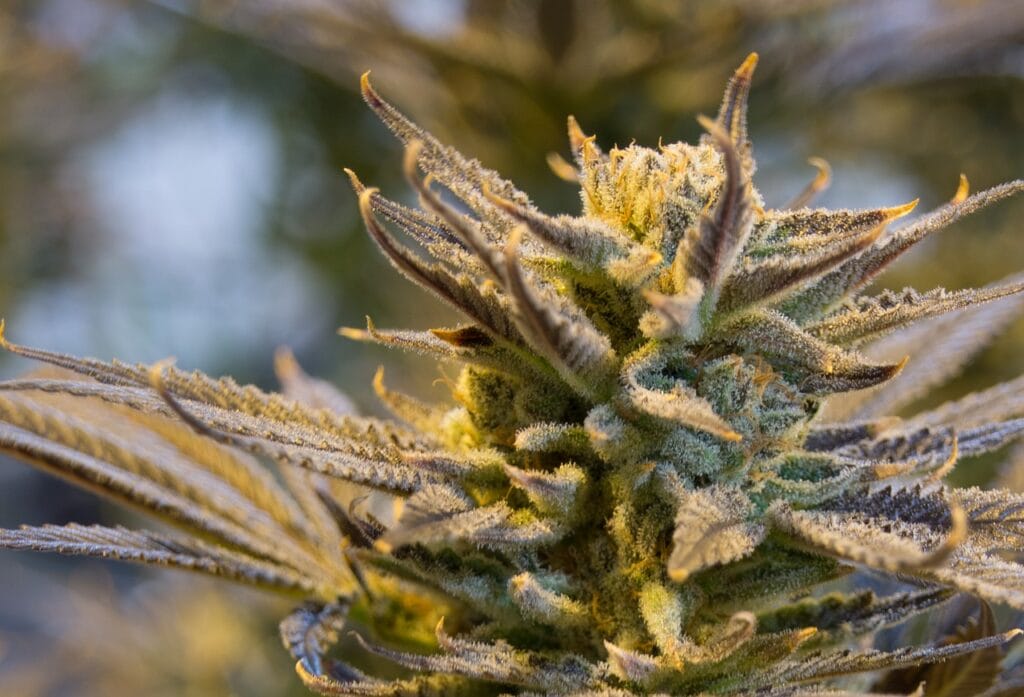An estimated 1.28 billion adults aged 30–79 have hypertension. Lifestyle changes and medication are treatment strategies to maintain blood pressure, but sometimes, these approaches are insufficient.
Studies show that the plant-based cannabinoid THC and the endocannabinoid anandamide can both lower blood pressure.
Read more to learn how Indica alongside Anandamide can manage blood pressure. To experience a substantial drop in blood pressure, you may want to buy Indica flower online.
Table of Contents
- Key Takeaways:
- Overview of Hypertension
- What is the Anandamide and Endocannabinoid System?
- How Cannabis and Anandamide Lower Hypertension
- Indica Cannabis Strains are a Mind-Body Medicine For Hypertension
- Manage Your Blood Pressure with This Selection
- Buy Indica Weed Online to Manage Hypertension
- Frequently Asked Questions

Key Takeaways:
- Anandamide and THC from cannabis Indica strains may help lower blood pressure by promoting vasodilation.
- Inhaling THC causes a significant drop in both systolic and diastolic blood pressure, as well as a reduction in intraocular (eye) pressure.
- Indica flowers can help relieve stress and anxiety, which may contribute to increased blood pressure.
Overview of Hypertension
A blood vessel pressure reading of 140/90 mmHg or above signifies hypertension, commonly referred to as high blood pressure. If left untreated, hypertension can escalate in severity. It occurs when the pressure exerted by blood against artery walls remains consistently elevated, thereby requiring the heart to pump blood with greater force.
There are two numbers in blood pressure readings. The first, or systolic number, is the pressure in the blood vessels when the heart beats. The second, or diastolic number, indicates the pressure in the vessels when the heart rests between beats.
Doctors diagnose hypertension if systolic blood pressure readings are ≥140 mmHg and diastolic blood pressure readings are ≥90 mmHg on two different days.
Types of Hypertension
- Primary hypertension: Tends to develop over many years. Plaque buildup increases the risk of high blood pressure.
- Secondary hypertension: Appears more suddenly than primary hypertension. It may be due to an underlying condition.
Treatment
Changing your lifestyle can help manage high blood pressure. Your healthcare provider may recommend lifestyle changes.
- Eating a heart-healthy diet with less salt
- Getting regular physical activity
- Getting 9 hours of sleep daily
- Maintaining a healthy weight or losing weight
- Limiting alcohol consumption
- Not smoking
Sometimes, lifestyle changes alone aren’t enough to treat high blood pressure. If they don’t help, your provider may recommend medication to lower your blood pressure.
The medicine used to treat hypertension depends on your health and the severity of your blood pressure. Two or more blood pressure drugs work better than one.
Scientific research is now exploring more natural approaches to managing hypertension, with cannabis taking center stage due to its interaction with the endocannabinoid system and anandamide.
What is the Anandamide and Endocannabinoid System?
Endocannabinoids, also called endogenous cannabinoids, are molecules made by your body. They’re similar to cannabinoids, but your body produces them. Experts have identified two key endocannabinoids so far, one being the anandamide (AEA)
Anandamide helps regulate bodily functions like movement, memory, appetite, and pain perception. Our bodies create AEA on demand, which triggers nervous responses through activating the body’s endocannabinoid system (ECS).
The ECS is a complex cell-signaling system that helps regulate sleep and mood. It consists of endogenous lipid-based retrograde neurotransmitters and cannabinoid receptors.
How It Works?
When the body experiences imbalance, it releases endogenous cannabinoids such as anandamide. It activates CB1 and CB2 receptors, which are endocannabinoid system components.
CB1 receptors exist in the central nervous system, lungs, liver, and kidneys. In contrast, CB2 receptors are in peripheral tissues such as the gastrointestinal tract, pancreas, and immune system-related tissues.
Anandamide plays a significant role in restoring the body to homeostasis through interacting with these receptors.
How Cannabis and Anandamide Lower Hypertension
Researchers have studied anandamide, the synthetic cannabinoid WIN55,212-2, and plant-derived THC in the context of hypertension. Research findings indicate that each of these cannabinoids lowers blood pressure by promoting vasodilation (widening of blood vessels).
Anandamide and THC bind relatively equally to CB1 and CB2 receptors, whereas synthetic WIN55,212-2 shows a higher affinity for CB2 over CB1 receptors. Studies suggest that both CB1 and CB2 receptors play a role in activating vasodilation.
Sativa strains and Indica plants contain cannabinoids that bind to CB1 and CB2 receptors.
Relevant Research Findings
Both the Nottingham and Washington, DC, studies indicated that the plant-based cannabinoid THC and the endocannabinoid anandamide mutually lowered blood pressure.
| Feature | Marijuana | Anandamide |
| Researcher | Howard University Hospital | University of Nottingham Medical School |
| Study Focus | The relationship between blood pressure and tetrahydrocannabinol (THC). | Investigated the cardiovascular responses to intravenous anandamide and WIN55212-2 in conscious male Wistar rats. |
| Participants | Human clinical trial | Researchers surgically prepared rats to measure arterial blood pressure and vascular conductance in the renal, mesenteric, and hindquarters vascular beds. |
| Results | Inhalation of THC increases heart rate, followed by a substantial drop in blood pressure (both systolic and diastolic) and as well a drop in intraocular (eye) pressure. | Anandamide decreased mean arterial blood pressure in rats with AII-AVP-induced hypertension through increased vasolidation. |
Indica Cannabis Strains are a Mind-Body Medicine For Hypertension
Research from Atlanta, Texas, and Harvard underscores a clear link between psychological attitudes and the development of hypertension. Anxiety, depression, impatience, and hostility are potential predictors of hypertension. These negative emotional states may increase the risk of high blood pressure over time.
Studies from the University of Texas have shown that people who maintain a positive self-concept and feelings of equality are less likely to develop hypertension.
Research from Harvard University also indicates that higher levels of curiosity and hopefulness reduce the likelihood of hypertension. These findings highlight the psychological factors that promote cardiovascular health and prevent hypertension.
Cannabis Flower for Managing Potential Predictors of Hypertension
Cannabis is a potential treatment for anxiety and depression. Many patients report that these conditions motivated their decision to seek cannabis treatment. Some use cannabis as a substitute for pharmaceuticals, with 16% replacing benzodiazepines and 12% replacing antidepressants.
93.5% of users tracking symptoms with a smartphone app reported lower anxiety levels after intake. Another study found that 71.8% of users reduced their prescription anxiety medication.
Bulk weed can also help with insomnia and chronic pain, which improves overall well-being and reduces blood pressure.
Manage Your Blood Pressure with This Selection
Want to manage your blood pressure with the relaxing and sedative effects of Indica? Online dispensaries offer a selection of strains that can help lower your blood pressure.
| Product | THC / CBD | Flavours | Experience |
| Bubba Kush | 22 / 0.6 | Vanilla, Apple | Deep, slow-breathing relaxation and a noticeable sense of physical comfort. |
| Cake Bomb | 24 / 0.2 | Citrus, Herbal | A strong body high will envelop you and leave you deeply relaxed and glued to the couch. |
| Cookies Kush | 20 / 0.5 | Minty, Pungent, Sweet | You’ll feel relaxed and at ease yet still have enough energy to function when needed. |
| Gorilla Glue | 26 / 0.9 | Coffee, Diesel | Your body will experience a deep, relaxing buzz, and you will feel completely stoned and immovable. |
| Platinum Candy | 21 / 0.2 | Earthy, Sweet | A soothing physical sensation washes over you in waves of deep relaxation. You will feel completely calm from head to toe. |
Buy Indica Weed Online to Manage Hypertension
Research suggests a potential role for Indica weed strains in managing hypertension by influencing anandamide levels. While conventional therapies focus on pharmaceuticals, alternative approaches like an Indica strain warrant consideration. This potential alternative has fewer side effects than traditional medications. Maintain your blood pressure with GrassLife’s selection of cannabis strains.
Frequently Asked Questions
How does THC interact with the ECS?
THC is one of the cannabinoids found in cannabis plants. It’s the compound that gets you “high.” Once in your body, THC interacts with your ECS by binding to receptors, just like endocannabinoids. It’s partly powerful because it can bind to CB1 and CB2 receptors.
This explains its strong effect—imagine it as a high dose of Anandamide. Unlike Anandamide, which your body can break down relatively quickly, enzymes find it more challenging to break down THC. This is why the effects of THC can last for several hours, while Anandamide’s effects are short-lived.
Can I smoke weed while taking hypertension medications?
Cannabinoids can interact with various heart disease medications, including blood pressure drugs, cholesterol-lowering statins, and heart rhythm treatments. Consult your doctor to know the appropriate amount and timing of cannabis use.
Can I use Sativa plants to manage hypertension?
Yes, you can use a Sativa strain to manage your blood pressure since this strain interacts with the CB1 and CB2 receptors. Indicas and Indica-heavy strains have a lower THC-to-CBD ratio, which promotes CB2 receptor activation. This activation is beneficial for heart health. The effects of CB2 receptor activation, such as anti-inflammation and anti-fibrosis, may counteract some of the actions of the CB1 receptor.
Related Articles:




